Traditional Welsh Cakes
This post may contain affiliate links. See my disclosure policy.
Unforgettably flaky, tender, almost melt-in-your-mouth texture that’s punctuated with sweet currants and laced with a wonderful hint of mace, these Welsh cakes are simply irresistible! A thoroughly authentic Welsh Cakes recipe from generations past.
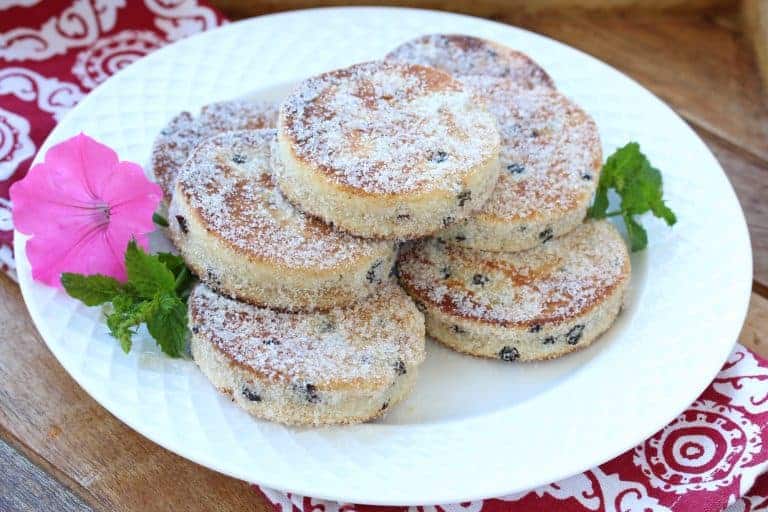
What Are Welsh Cakes?
Welsh cakes, also known as bakestones or “picau ar y maen” in the Welsh language, are popular, traditional Welsh baked goods that are flat, round, and resemble griddle scones. They are traditionally made from flour, lard, sugar, and dried currants and often a hint of warming spices like cinnamon and mace. They’re cooked on a griddle or heavy skillet which gives them their characteristic slightly crispy exterior while keeping the interior soft and meltingly tender. Once cooked they’re coated in sugar and served warm. An important and beloved part of Welsh culinary heritage, Welsh cakes are enjoyed as an everyday treat or served on special occasions like St. David’s Day.
A Brief Introduction to Wales
Before we get to the recipe, let’s talk just briefly about the beautiful country that is home to these delicious Welsh Cakes. Wales is a breathtakingly scenic country with mountainous national parks, glacial landforms, rugged coastlines, some of the most striking fortresses in the world, picturesque villages, and steeped in a rich Celtic culture.
And then of course there is the Welsh language which is near maddening to anyone who can’t speak it (99.999% of the world). Yet even the mind-boggling, tongue-twisting language is an endearing aspect of this beautiful country.

I visited Wales regularly during the 6 years I lived in England and my husband also lived in Wales for nearly a year as a young adult. There’s a small village in Wales that has the longest place name in the UK and second longest in the world. Todd prides himself in being able to say the name, all 58 letters, at break-neck speed and without even the slightest hiccup: Llanfairpwllgwyngyllgogerychwyrndrobwllllantysiliogogogoch.
And just in case you don’t believe me, we visited the village this Summer and I took a picture of the sign:
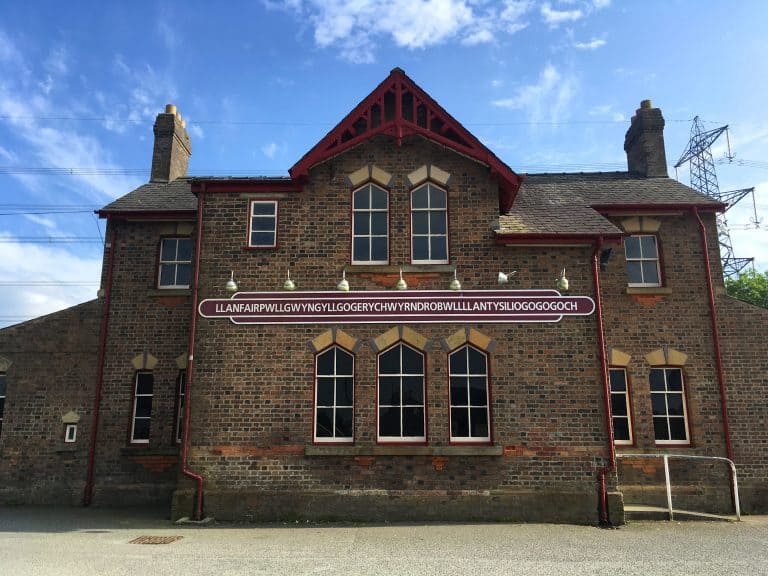
So you have these charming quirks in Wales and then you also have the jaw-dropping, awe-inspiring landscapes and architecture. Todd and I both absolutely love Wales and just got back from a recent vacation there with our kids, focusing this time on North Wales. Here are just few representative pictures of the area.
Below left: The Great Orme. Below right (top and bottom): Snowdonia National Park.

Below are a few of Wales’ most striking and famous castles, all built by Edward I in the 13th century.
Below top left: Caernarfon Castle, where historically the Prince of Wales was crowned and that tradition was resumed with Prince Charles. Below top right: View from Harlech Castle.
Below bottom left: Beaumaris Castle, considered the finest textbook example concentric castle design in the world. Below bottom right: Harlech Castle, also considered an example of the finest medieval castle designs in the world.

Below: Conwy Castle, considered one of the finest defensive castle designs in the world.

The Killebrew’s at Beaumaris Castle.
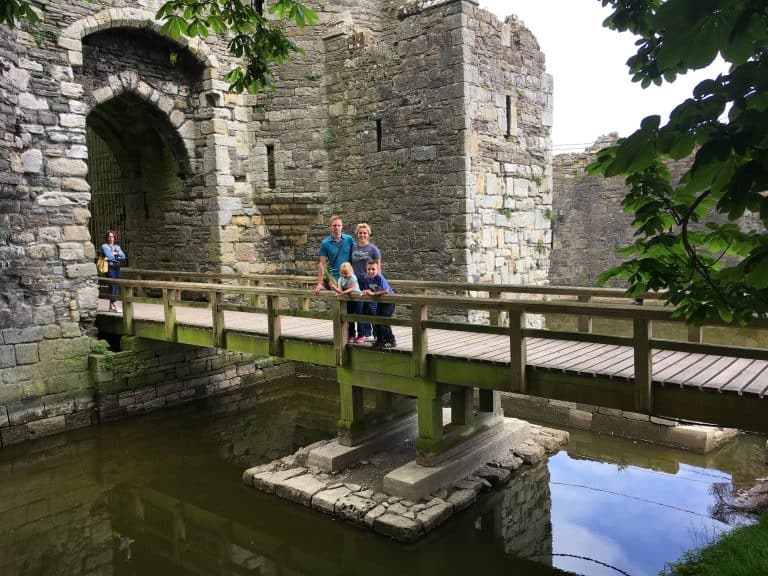
Wales also has a special place in my heart because it’s home to many of my ancestors. My great grandparents on my father’s maternal side were from South Wales and I also have a long line Welsh ancestry in North Wales that goes back to Roman times.
It was my great-grandparents, the Thomas Family from Glamorganshire, Wales, who immigrated to the United States, to Utah, in the late 19th century.
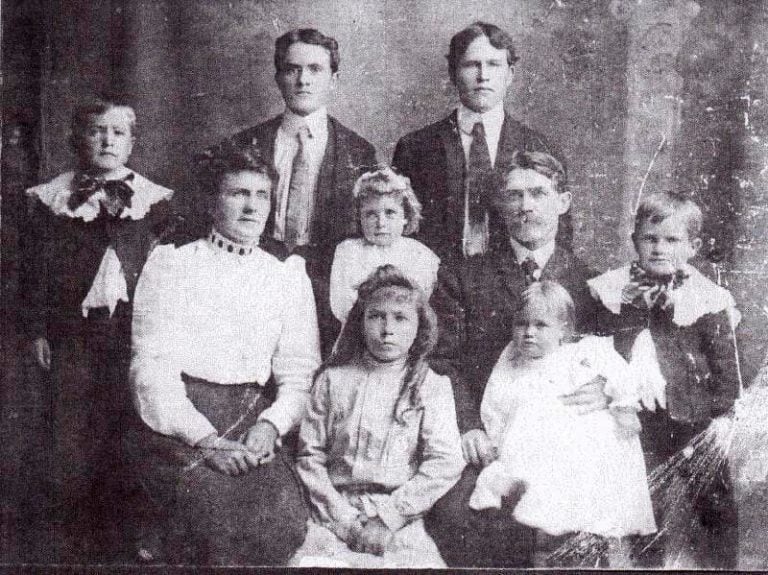
I’ve always wished some of my great grandmothers would have left some journals or recipes to pass down. What a treasure that would be! Nevertheless, I like to imagine my Welsh great-grandmother, Dinah, making these Welsh cakes in her kitchen and her children enjoying them hot off the griddle and dusted in sugar.
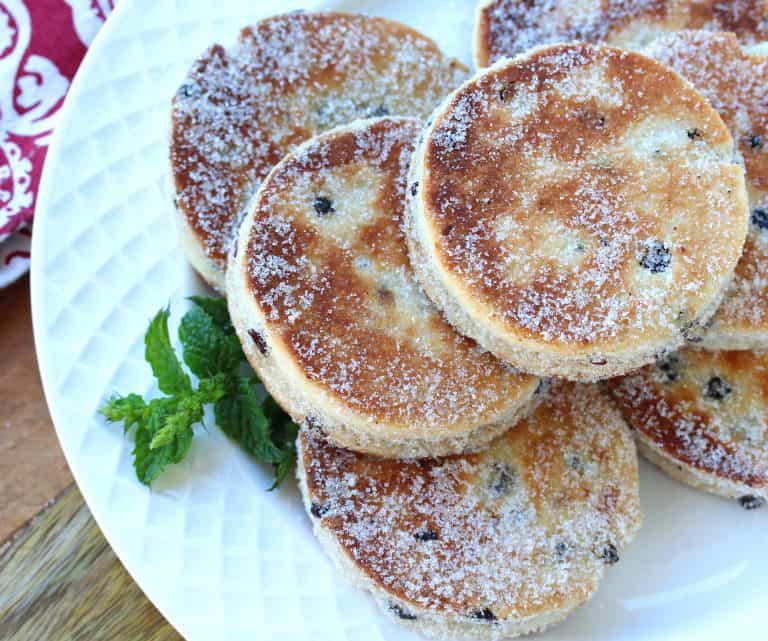
So in honor of the beautiful country of Wales and my Welsh heritage, I’m sharing a very authentic recipe for traditional Welsh Cakes. In Wales these are also known as “bakestones” because traditionally they were cooked on a bakestone which is a cast iron griddle that was placed on the fire or stovetop.
If you’ve never had Welsh Cakes before, I think you’ll agree once you try them that they’re quite different from anything you’ve had before. With their unforgettably flaky, tender, almost melt-in-your-mouth texture that’s punctuated with sweet currants and laced with a wonderful hint of mace, Welsh cakes are simply irresistible.
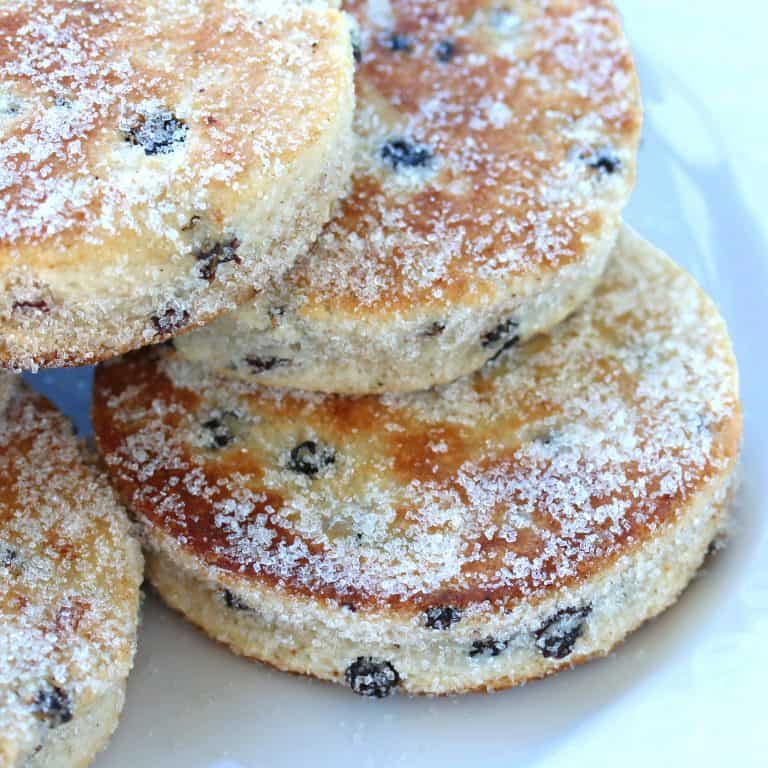
And if you have had Welsh cakes before but your opinion (whether or good or bad) is based solely on store-bought ones, set that opinion aside because I promise you you’ll form a whole new opinion once you’ve tried homemade ones. I’ve had store-bought Welsh cakes on a couple of occasions and I don’t care for them.
But…HOMEMADE…that’s an entirely different story. I am IN LOVE with these traditional homemade Welsh cakes!! Let me say it again: NOTHING compares to the traditional homemade version of these cakes using real lard and mace! They are FABULOUS. Just trust me on this enough to give them a try.

How to Make Welsh Cakes
Use lard. Do not substitute with additional butter. Lard makes ALL the difference in the texture. I repeat: Lard makes ALL the difference in the texture. I highly recommend making your own lard – it’s super easy! Learn How to Make Lard.
Use dried currants. In spite of their name, they’re actually not dried currants at all but rather a variety of raisin known as zante raisins. They’re much smaller than regular raisins, not as cloyingly sweet, and are firmer in texture (regular raisins will be too large and too mushy in these). Dried currants are a staple in traditional British baking and a must for making Welsh cakes.
Use mace. Don’t substitute nutmeg. Mace is a wonderfully aromatic and flavorful spice that was commonly used generations ago but is unfortunately less common today. Its really adds a special and nostalgic touch of old-fashioned flavor.
Use caster sugar. This is also critical for the texture. Since these Welsh cakes are cooked pretty quickly, regular granulated sugar will not have time to dissolve and the texture will be grittier as opposed to that smooth, almost melt-in-your mouth consistency we’re after. Caster sugar is ultra-fine sugar and dissolves very quickly. You can buy caster sugar or very simply make your own by running regular sugar through the blender until very fine. Do NOT use powdered sugar – it contains cornstarch and is not the same thing.
Traditional Welsh Cakes Recipe
Let’s get started!
In a bowl combine the flour, sugar, baking powder, salt, mace and cinnamon. Mix in the lard and butter using your fingers or a food processor until the mixture resembles coarse crumbs.
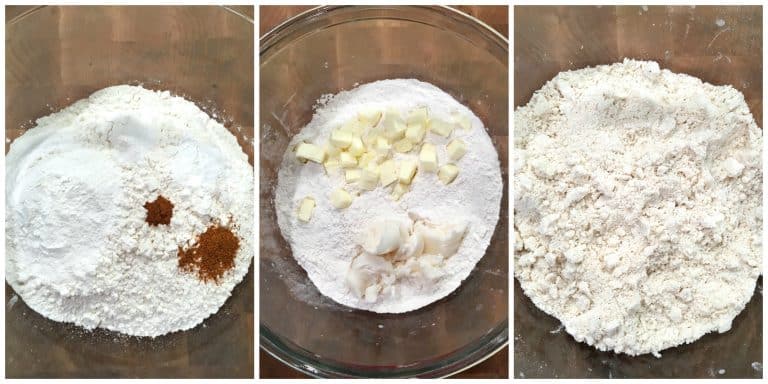
Add the currants and stir to combine. Add the beaten egg and work it into the mixture adding a little milk as needed until you have a soft dough. It should not be wet or sticky.
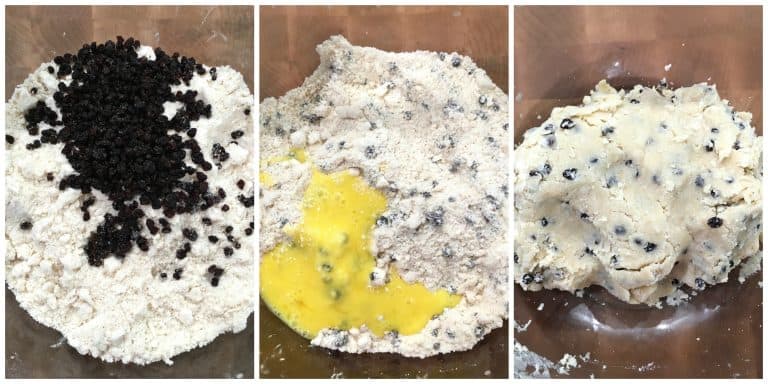
Wrap the dough and refrigerate for 30 minutes. (Dough can be made well in advance and chilled until ready to use.)
Roll the dough out onto a floured or non-stick surface about 1/4 inch thick. Cut out rounds using a biscuit cutter.
Gather up the scraps, knead together and roll out again to cut the remaining rounds.
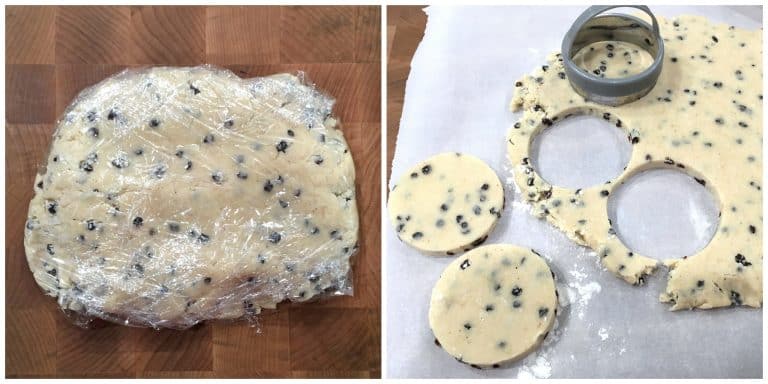
Heat and lightly butter a cast iron pan over medium heat. (I use and love my Lodge cast iron pan for these Welsh Cakes.)
Add the cakes and cook on each side until lightly browned, about 3-4 minutes (lower the heat if needed to prevent the outside from burning before the interior is done).
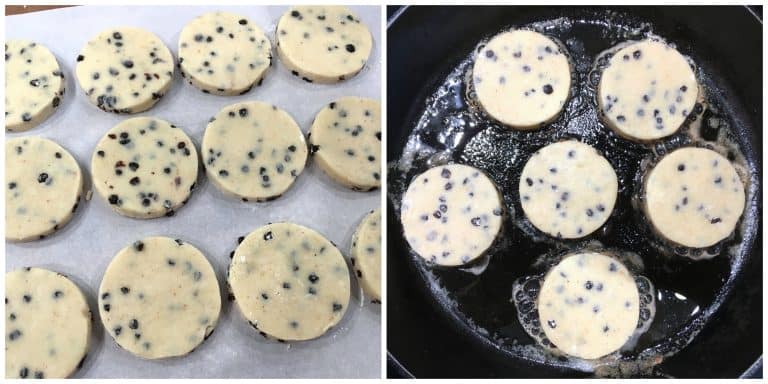
Once the Welsh cakes are done, remove them from the pan and let them cool for a minute.
While the Welsh cakes are still warm, place them in a small bowl of sugar to coat all sides.

Best eaten while a little warm. Reheat Welsh Cakes in a pan, toaster, or warmed oven (or if in a hurry, in the microwave for a few seconds).
Enjoy!
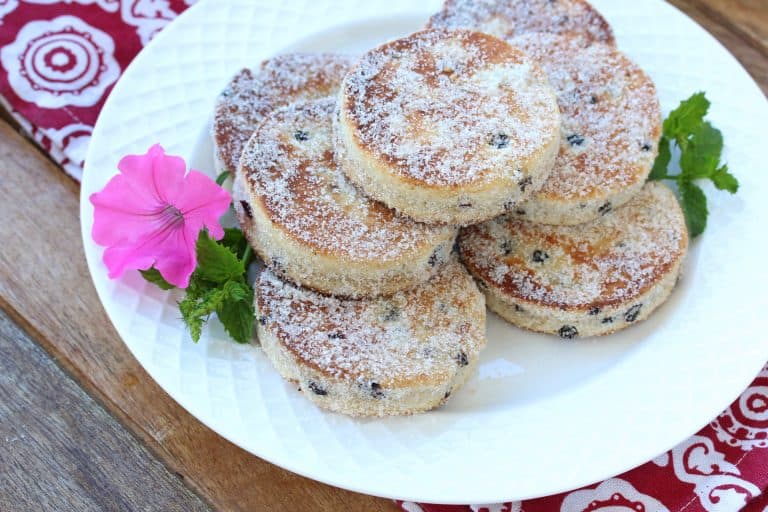
For more traditional Welsh and British bakes be sure to try my:
- Bara Brith
- Treacle Tart
- Sticky Toffee Pudding
- Spotted Dick
- Chelsea Buns
- Cornish Fairings
- Victoria Sponge Cake
- Hot Cross Buns
- Mince Pies
- Lardy Cake
- Scottish Shortbread
- Flapjacks
- Parkin
- Eccles Cakes
- Crumpets
Save This Recipe
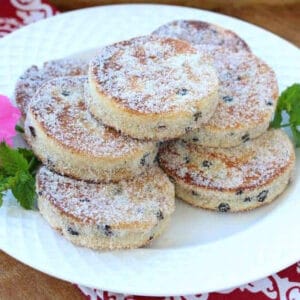
Traditional Welsh Cakes
Ingredients
- 2 cups all-purpose flour
- 1/3 cup caster sugar (do not substitute) (to make your own, pulse granulated sugar in a blender until ultra fine. Do NOT use powdered sugar)
- 1 teaspoon baking powder
- 1/2 teaspoon ground mace ,(a highly fragrant, flavorful spice used in a lot of traditional baking. STRONGLY recommended but can substitute nutmeg if necessary)
- 1/4 teaspoon salt
- 1/8 teaspoon ground cinnamon
- 2 ounces lard , chilled (about 4 tablespoons) NOTE: Lard is critical for the wonderful texture of Welsh Cakes
- How To Render Your Own Lard! (it’s WAY cheaper and better)
- 2 ounces butter , chilled and cubed
- 1 large egg , lightly beaten
- 1/2 cup dried currants
- 2-3 tablespoons milk
- granulated sugar for finished cakes
Instructions
- In a bowl combine the flour, sugar, baking powder, salt, mace and cinnamon. Mix in the lard and butter using your fingers or a food processor until the mixture resembles coarse crumbs. Add the currants and stir to combine. Add the beaten egg and work it into the mixture adding a little milk as needed until you have a soft dough. It should not be wet or sticky. Wrap the dough and refrigerate for 30 minutes. (Dough can be made well in advance and chilled until ready to use.)
- Roll the dough out onto a floured or non-stick surface about 1/4 inch thick. Cut out rounds using a biscuit cutter. Gather up the scraps, knead together and roll out again to cut the remaining rounds.
- Heat and lightly butter a cast iron pan over medium heat (I lightly butter it to later help the sugar adhere to the cakes when they’re sprinkled). Add the cakes and cook on each side until lightly browned, about 3-4 minutes (lower the heat if needed to prevent the outside from burning before the interior is done).
- Let them cool for about a minute. While the Welsh cakes are still warm, place them in a small bowl of sugar to coat all sides. Best eaten while a little warm. Reheat Welsh Cakes in a pan, toaster, or warmed oven (or if in a hurry, in the microwave for a few seconds).
Nutrition
Originally published on The Daring Gourmet October 30, 2018



















. You can make the cakes and lay them on a cooking tray layered between grease paper and cook them when you are ready.
These are delicious! I just coated the tops with sugar to make less of a mess. They were still sweet enough. Thank you.
Thank you, Marla, I’m so glad you enjoyed them!
Also a “ transplant “ from South Wales ( NEATH, Glam.)in the sixties Writing from the Eastern Townships ( QUEBEC,CANADA
STILL miss the beaches !Have a smattering of CYMRAEG & can say LlanPG along with the best of them 🏴Will definitely try this .,especially since March 1st.coming up soon . LAMB ( tho.sadly not Welsh) for dinner that night 👍
Very nice, Margaret! The beaches and coastline are amazing. We were supposed to go back again last year but…2020. Hopefully soon. Happy baking and I hope you enjoy these Welsh Cakes! Cymru am byth! :)
Thank you for your lovely story and pics from Wales. We really enjoyed them. I haven’t tried the recipe yet for the Welsh cakes but will in the near future. Wish me luck!
Thank you so much, Joyce, and I hope you take the opportunity to make these, they’re really special! :)
If I can’t find lard, and don’t have the (or inclination to render my own), can I substitute shortening?
Hi Yvette, if you don’t have lard I recommend just using butter.
These look absolutely delicious. (Love your travelogs and commentaries!). So, why butter instead of shortening if lard not available?
Thank you, Gail! :) I’m not a fan of shortening for health reasons and I just can’t in good conscious recommend it to anyone. I discuss Crisco/shortening in detail in my article here, near the top: https://www.daringgourmet.com/how-to-render-lard-and-why-you-should-use-it/
What about beef suet? Would that work, or would the flavor be too strong?
Shredded beef suet? No, it would have to be rendered (melted down in “scoopable” form like butter and pork lard). And even then, when beef tallow comes to room temp it’s much firmer/harder than pork lard. I wouldn’t recommend it for Welsh cakes.
Kimberly, my Grandmother came to America (Oregon) from Holly Bush (just outside of Cardiff). I remember her making Welsh cakes when I was young but don’t have her recipe for them. Thank you for yours I had no idea about the lard and am looking forward to making a batch. My only question is have you ever soaked the currants first and would that work?
Hi Sharon, the currants aren’t typically soaked and I haven’t tried that. My worry would be that they’ll be too wet and compromise the texture of the Welsh Cakes. I’d recommend proceeding as directed without the soaking and see what you think. The lightly chewy currants add a wonderful texture component. Happy baking and please let us know what you think! :)
How do I make the lard please.
My grandfather Jonah Bevan and my great and great great grandparents were Welsh.
I would love to make these.I’m in my early 70’s And I married a Scotsman.
Hi Jan, here is the link to the tutorial on how to render lard: https://www.daringgourmet.com/how-to-render-lard-and-why-you-should-use-it/. Have fun and happy baking! :)
Kimberly’s method for making lard works well. I get ten pounds of pork fat from my butcher and this will cook down to about 3 qts of lard. For making pie, lard is a game changer.
Gary
Hi, want to make these but they won’t get eaten straight away. How long will the dough keep in the fridge before having to use it or can you freeze the dough?
Hi Karen, I haven’t tried freezing them but I’ve kept the dough in the fridge for 4 days before and they turned out great.
My Grandmother Thelma Howell’s family came from Glamorgan too (1860’s) and went to Utah, then Colorado and then California. Cannot wait to try these Welsh cakes…
I rolled them out the first time and then had a time saving idea. I rolled the dough into a log. This morning I just sliced what I needed so no cookies cutter or rolling pin necessary. These are scrumptious 🤗
Just FYI, like most truly old recipes, there really isn’t a definitively traditional way to make them.. which means that lard (while some use it, and you clearly like it) is definitely not essential. We have Victorian family recipes that very definitely state to use butter, which is what I still do to this day.
Not knocking your enthusiasm for lard and maybe I’ll give it a go sometime, just wanted to point out that it’s not integral (especially for vegetarians who might want to try picau ar y maen!) :)
Hi, I am 2nd generation removed from Glyncorrwg, Wales (Grandmother’s side and my heart yearns to get there before I go to Haven. She was of a ‘different breed’ and was an awesome cook – featuring pasties and Welsh cookies. I teared up a bit reading your site and have been searching for THE recipe – finding several, but none touched my heart as did yours. I shall get to the kitchen and start. I have no cast iron, but do have an electric grill.
Thank you, Maurice. I hope you enjoy these cakes and that they connect you with your heritage and with the loved ones who have gone before you <3
i have my moms recipe the same as above! This is the real welsh cake recipe!
I make every year / i do put the dough in the refrigerator for a night than leave out 20 min room temp before rolling out
I also use a grill just like my mom did!
I bought some Welsh cakes at a farmer’s market which were divine and I can’t wait to make my own! I’m thinking of making an orange/cranberry or blueberry/lemon since my family isn’t too found of currants.
Pop a bit of lemon rind in there to wake up the mace, and you’ll have em singing hymns and arias in no time!
Thank you so much for the detailed recipe.I followed it precisely and the cakes turned out owesome and tastes divine.
Wonderful, Jahnavi, thank so much!